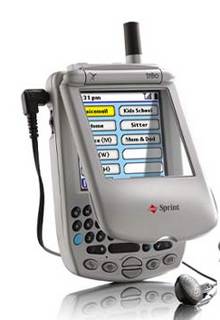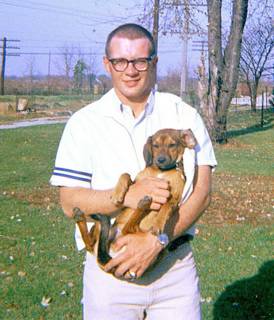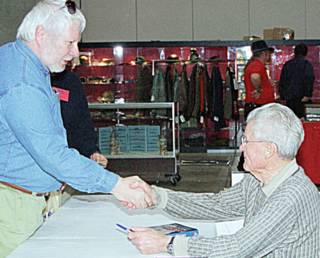
The fabulous Treo 300 - it's a PDA, it's a cell phone and because it's already been supplanted by the Treo 600, it's ridiculously cheap.

The dark mutterings of a former mild-mannered reporter for a large metropolitan daily newspaper, now living in obscurity in central Indiana.












I kept a promise to myself this year.
On June 24, 1991, when I rode my new pearl silver 1991 K100RS out of the dealer's parking lot, I vowed that one day I'd see the odometer turn over 100,000 miles.
I remember chuckling at the audacity of BMW to put an odometer on their K-bikes that would read so high: Most bikes are junk long before their odometers need a sixth digit. But I knew this bike could do 100 grand and lots more.
I really wasn't in the market for a new bike back in the spring of '91. I had 80,000 miles on my 1981 R100RS and still had big traveling plans for that elegant graphite twin that had shown me so much of the country. I figured I'd eventually replace it with another R100RS, since the RS riding position suits me so well.
One afternoon, just to humor my local dealer, I took one of his new 16-valve K100s out for a demo ride. In less than 15 minutes, I was utterly seduced by the power and the handling of the new K. As I headed back to the dealership, I was doing the math to buy one of these amazing machines.
Luckily, this seduction came at a time when my finances made the purchase possible and the new bike was soon mine.
A few weeks later, I headed west for a week in Breckenridge, Colo., with BMW Club friends and then on to the Top O' the Rockies Rally in Paonia, Colo., then down through southern Utah to the BMW MOA National Rally in Flagstaff.
I remember how proud I was riding into the rally at Flagstaff. Heads turned. Riders gathered around to ogle the bike whenever I stopped. This was, after all, the new flagship of the BMW line – the latest example of the legendary BMW engineering prowess.
In the intervening six years, the bike carried me through 31 states and two Canadian provinces.
We've climbed the highest paved road in the United States to the summit of Mount Evans and we've screamed across the Nevada desert at just under 150 mph.
It's performed reliably in temperatures ranging from 20 below zero to 115 above.
Together, we've carved twisties from Deal's Gap to Big Sur, endured savage Kansas crosswinds and Wyoming hailstones. We've split lanes in Los Angeles freeway rush hour traffic and passed solitary hours cruising the Natchez Trace and the Blue Ridge Parkway.
We've raced thunderstorms across Utah wastelands and probed California redwood forests so deep and dense it was dark at midday.
This magnificent machine has carried me across the Golden Gate and down Highway A1A to Key West and up the backbone of the Canadian Rockies from Banff to Jasper.
My memory is flooded with images from the saddle:
* Endless fields of North Dakota sunflowers at sunrise, each turning its golden face to the rising sun that warmed my back.
* The haunting tragic sadness of the Shiloh battlefield.
* Riding the white sands of Daytona Beach.
* The incredible intoxicating sweet aroma of desert flowers after a Wyoming thunderstorm.
* Mount Hood shining at the western end of the Columbia River Gorge.
* An unseen Ponderosa pine forest filling my helmet with fragrance as I rode into Flagstaff at midnight.
* The snow-clad majesty of the Colorado Rockies as I-70 ascends to the clouds west of Denver.
* The hellish sulfur pits of Yellowstone.
* Dodging rubber shrapnel as the car in front of me shredded a tire and veered to the median of a California freeway.
* Climbing to the snowy summit of Independence Pass before attacking the twisty road down to Aspen and lunch at the Woody Creek Tavern.
To be fair, there have been problems. This bike, like many of its generation, had chronic exhaust system problems. It liked to break welds between the header pipes and the muffler and did so in the summers of '92, '94 and '95. In the summer of '93, it broke a baffle in Nebraska. Each time, BMW replaced the $1,800 exhaust system under warranty. Finally, when a weld failed at Mount Rushmore in 1995 and BMW couldn't get a replacement to me quickly, I rode to California BMW at Mountain View and stepped up to a Staintune. A year later, the Staintune ripped itself apart 60 miles west of Oklahoma City. It was replaced under warranty with what was touted as a more robust version. A year later, the header pipe developed a spiral crack and was replaced under warranty in what proved to be the final fix.
The top end of the engine had a bad exhaust port and was replaced at 30,000 miles. I replaced the alternator in Portland, Ore., in 1996. The fan quit in Tennessee in October, 1997, shooting a geyser of coolant out of the right side cover.
When I took delivery of the bike, I only made two minor modifications – I added a front fender extension to protect the radiator and belly pan and I installed a luggage rack.
I love the clean, sculpted look of the bike and took care that subsequent tweaks preserved the look. I upgraded the headlight with a 100/80-watt bulb, added a Hyperlite flasher to the brake light, replaced the right bar end weight with a Wrist Rest cruise control, swapped the stock clock for a Fuel Plus clock/fuel calculator and replaced the wrung-out stock shock absorber with a Works shock. I also replaced the stock black saddlebags with custom painted matching pearl silver bags.
I estimate I've gone through 26 tires – 16 front and 10 rear – and filled the tank about 450 times.
I could go on to tally the quarts of oil and how much I've spent on service, but that's stuff for the bean counters.
And I hate bean counters.
So that's why, when 99,999 yielded to 100,000 at 5:10 p.m. Oct. 19, 1997, all I could think about was how rich in experience and spirit this fabulous machine has made me. It was, without question, the best deal I ever made.
Now, let's see how soon we can get to 200,000.









